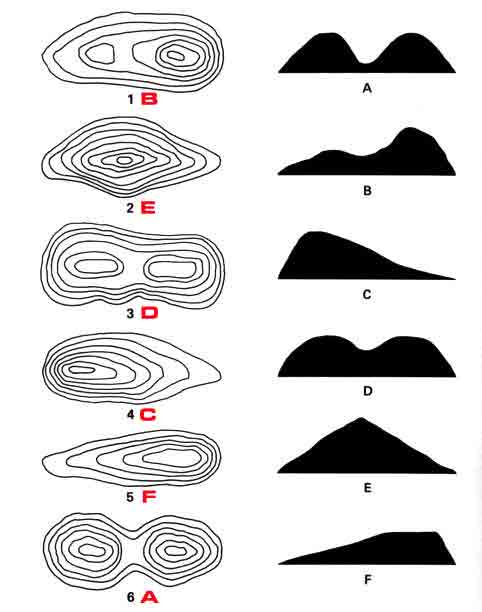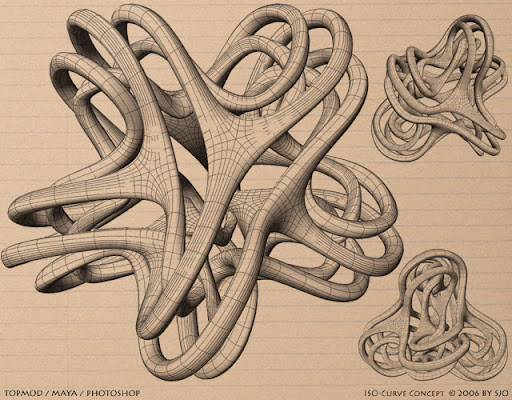What is topology????
-
Here are some leaders by TT: http://forums.sketchucation.com/viewtopic.php?t=39442
But why are you burying this topic in the board issues forums? Should go to SketchUp or similar
-
Topology is the structure of a shape. In SketchUp, we would understand it as the connectivity between faces, edges, vertices, disregarding where exactly they are positioned (this is why a vertex is not identical with a point).
It is about abstract properties of a shape (like the amount of sides or holes) that can't be changed by deformation. If you deform a Möbius strip, it will always have one side; if you deform a Pretzel, it will always have three holes unless you disconnect some parts. -
@unknownuser said:
But why are you burying this topic in the board issues forums? Should go to SketchUp or similar
Sorry wasn't sure where to post

-
This thread is a useful one to read on the topic of topology:
http://blenderartists.org/forum/showthread.php?93651-Poles-and-Loops -
@iichiversii said:
Iv being researching the term topology, but not understanding it completely
topology, in a simple way, has to do with the shape of a surface.
@iichiversii said:
Is there a way to convert to quads for use in other 3D applications resulting with good topology?
Blender for example has a command during edit mode to "convert tris to quads", and as long as the arrangement of your triangles from sketchup is based on quadfaces, the conversion works very well.
-Andy
-
@unknownuser said:
Blender for example has a command during edit mode to "convert tris to quads", and as long as the arrangement of your triangles from sketchup is based on quadfaces, the conversion works very well.
So in other words proper planning and perpetration of tris in SU, converted to quads in blender can create good topology?
-
"Good topology" is a relative concept -- good for what exactly? You would have different requirements for character animation than you would for sculpting... but both approaches generally want to avoid poles (because they do not subdivide well, among other issues).
Best,
Jason. -
@unknownuser said:
So in other words proper planning and perpetration of tris in SU, converted to quads in blender can create good topology?
It depends on your definition of good topography... Some programs require quads to do certain functions. quad is a more efficient mathematical description, so it's faster within the software, it has it's benefits, but once the model is textured and rendered the end result is hardly noticeable. The only major factor for me in quads is program and model efficiency. 99% of the time there are going to be tris somewhere in a model, unless you model boxes only.
As Andybot said so eloquently...
@unknownuser said:
topology, in a simple way, has to do with the shape of a surface.
everything has topography, the level of detail that is needed for any certain project determines the topography. However in my line of work (architecture) we have predefined levels of detail and topography is a term used for the mapping of land characteristics such as peaks, valleys and waterways. Example we would have a map that was accurate to 2' or 10' and we use industry standards to map height or elevation data, then we use a slicing technique to show the same elevations lines and how they connect.
like in this example you can see how the mapping will follow height from it's base reference. say sea level.

Now you can build these surfaces with tris and in some software you could build it with quads, but in the end the only difference will really be model efficiency. Both models would render out the same results. Albeit perhaps slower on the tris...
Now when you're texturing your model it might come in handy to have fluid quad references lines on your mesh map... and then again it might not if you were texturing land like I do.
Hope this helps you understand a little bit more about the term.
-
Kris, Thanks, but I think I may have oversimplified. Topology has to do with the underlying structure of the shape as well - which is why we're talking about quadfaces versus tris. Topography is a bit different - it means (again, generalizing
 ) to map the shape of a surface.
) to map the shape of a surface. -
Thanks lads, I finally understand the term topology, cheers for your help

-
If you want a topologic modeler, try the crazzy TopMod!


-
As previously answered topology is the mathematical science that relates to shapes.
Its benefit is that the development as a mathematical tool allows it to be applied systematically to what essentially we do in the 3D world of design, regardless of particulars (a sphere and a cube are topologically identical).Now the tri/quad issue comes from somewhere else I believe.
First pure geometry: a plane can be defined with a minimum of three points: three are sufficient and necessary. Thus the trigons of meshes, as every elemental plane is defined by three points.
A fourth point would have to be precisely aligned with the other three to be "in the plane"
And that is why historically we had tris. Also when computer started to become powerful calculating machines a lot of complex interaction and calcualtion was easier in terms of three (Finite Elements, non linear functions, etc..)I am not sure why quads were introduced, and what benefits they offer over tris, so I will let other speak of that. My assumption is for simplification of calculation (time mostly) but there may be other reasons.
In any case any quad element can always be decomposed into two tri elements. Not sure if the reverse is true (odd number of triangles ) but I presume that is the way to convert from one to the other.
As far as I can tell, SU uses quads for cylinders, and converts them to tri as soon as you attempt to modify. (Draw a cylinder, show hidden, apply rotate tool to top face) -
Just another taught, or should I say question, if you were to create the same Model twice at the same scale, 1 made with tris and the other with quads would the number of polygons in the model created with tris be greater than the 1 made of quads, or would I be completely wrong?

-
I believe at the end for a render program that 1 quad = 2 Tri

-
@iichiversii said:
Just another taught, or should I say question, if you were to create the same Model twice at the same scale, 1 made with tris and the other with quads would the number of polygons in the model created with tris be greater than the 1 made of quads, or would I be completely wrong?

I don't know but here what I think:
1- It depends on the program, and the rules for creating the polygons
2- It depends on what is important (level of resolution, where) for each type
3- Why is the "greater" important? If it's to assess speed, it also will depend on speed of treatment, if you have less quads but they take longer to be treated, then no gain in speed right, so what is really the worry about the number? -
@michaelv said:
@iichiversii said:
Just another taught, or should I say question, if you were to create the same Model twice at the same scale, 1 made with tris and the other with quads would the number of polygons in the model created with tris be greater than the 1 made of quads, or would I be completely wrong?

I don't know but here what I think:
1- It depends on the program, and the rules for creating the polygons
2- It depends on what is important (level of resolution, where) for each type
3- Why is the "greater" important? If it's to assess speed, it also will depend on speed of treatment, if you have less quads but they take longer to be treated, then no gain in speed right, so what is really the worry about the number?It's of no great importance, the size, just a quest for a better understanding of topology and the pros and cons of quads and the difference between them, that's all, I myself needed a better understanding of good topology and hopefully this will help others who seek a better understanding also in the future

Advertisement







